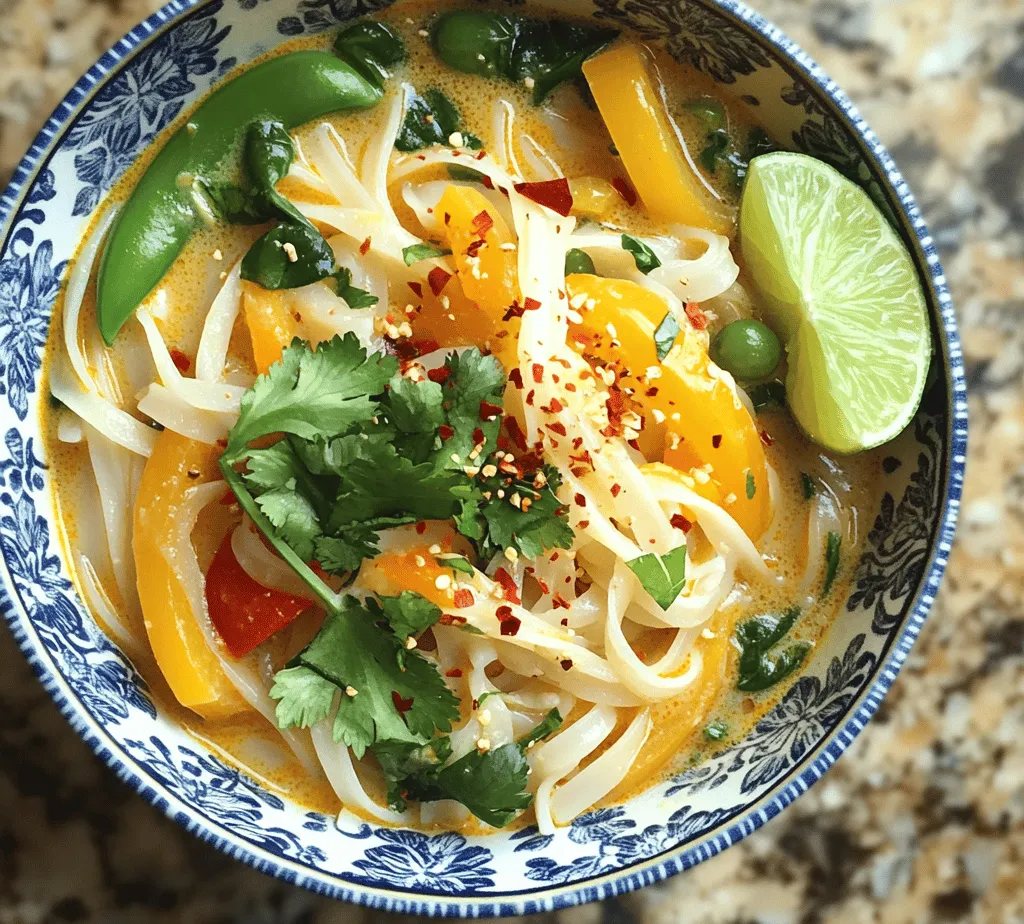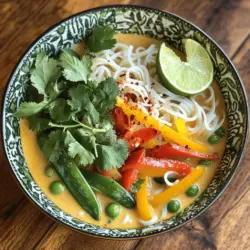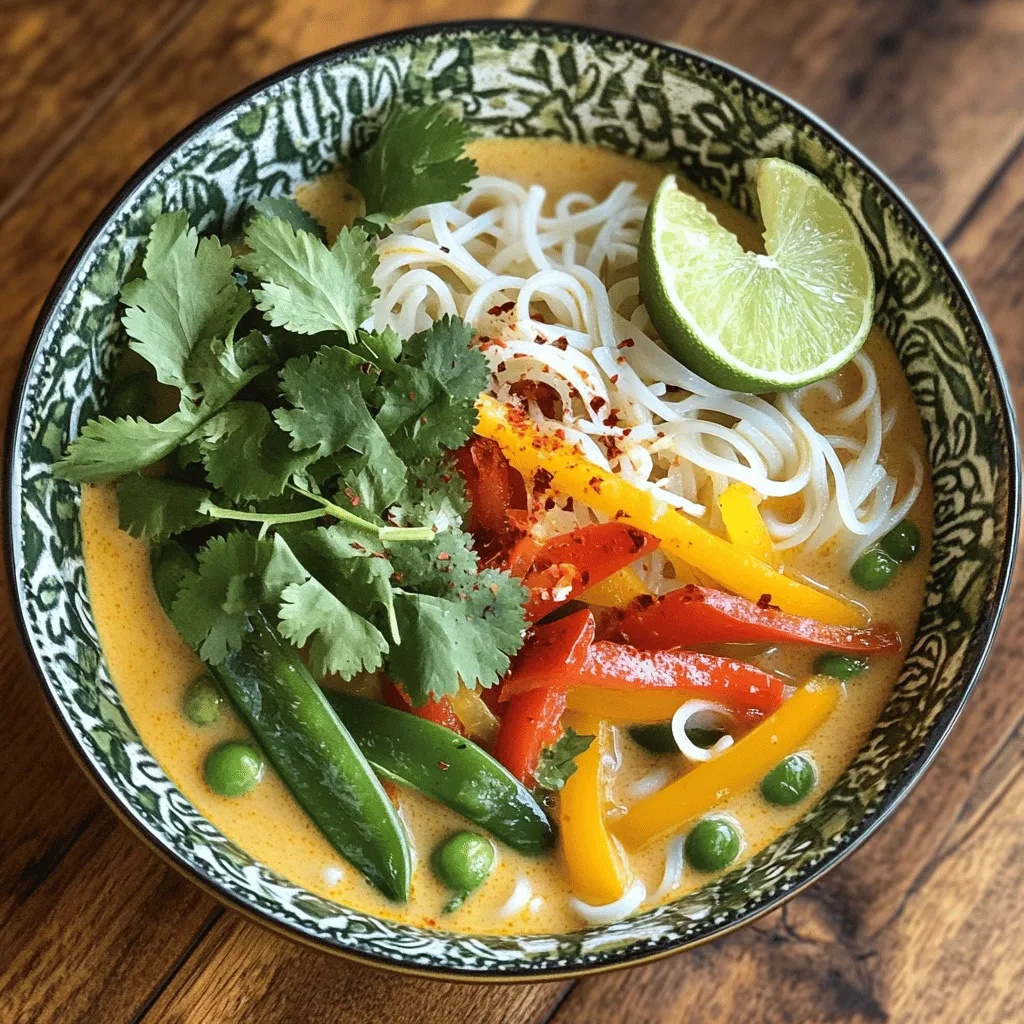Introduction
Thai cuisine is renowned for its vibrant flavors, aromatic ingredients, and balance of sweet, sour, salty, and spicy elements. Each dish tells a story, reflecting the rich culture and culinary traditions of Thailand. Among the myriad of delightful dishes, Spicy Thai Red Curry Noodle Soup stands out as a comforting favorite that tantalizes the taste buds while also nourishing the body. This soup is a perfect representation of Thai cuisine, offering a harmonious blend of spices, the creamy richness of coconut milk, and an array of colorful vegetables.
Spicy Thai Red Curry Noodle Soup is not just about heat; it’s about balance. The spiciness of the red curry paste is beautifully countered by the creaminess of coconut milk, creating a flavor profile that is both bold and comforting. The soup is packed with nutritional benefits, thanks to the fresh vegetables and protein choices that can be tailored to suit dietary preferences. Whether you’re a seasoned Thai food lover or a newcomer eager to explore, this dish promises to deliver satisfaction in every spoonful.
Understanding Thai Red Curry
At the heart of this delicious soup lies Thai red curry paste — a cornerstone of Thai cooking that elevates the dish with its complex flavors. Thai curry pastes are typically made from a blend of fresh herbs, spices, and aromatics, making them essential for creating authentic dishes. Red curry paste, in particular, is known for its deep red hue and rich flavor, which comes from a combination of dried red chilies, lemongrass, galangal, and kaffir lime leaves.
The ingredients found in Thai red curry paste vary by region and personal preference, but some common components include:
– Dried red chilies: The primary source of heat and the vibrant color in the paste.
– Lemongrass: Adds a bright, citrusy flavor that complements the other spices.
– Galangal: A relative of ginger, it brings a unique earthiness and warmth.
– Kaffir lime leaves: Infuse a fragrant, zesty aroma that is characteristic of Thai cuisine.
– Garlic and shallots: Essential for a robust base flavor.
The health benefits of these spices and herbs are significant. For instance, ginger and garlic are known for their anti-inflammatory properties, while lemongrass may aid in digestion. This combination not only enhances flavor but also contributes to the dish’s overall nutritional value.
Ingredients Breakdown
To create a satisfying bowl of Spicy Thai Red Curry Noodle Soup, you will need a selection of fresh ingredients that work together to build layers of flavor. Here’s a detailed breakdown of each component in the recipe:
Rice Noodles
Rice noodles are a staple in Thai cuisine, known for their delicate texture and ability to absorb the flavors of the broth. When preparing your soup, it’s essential to choose the right type of rice noodles. Flat rice noodles, such as those used in Pad Thai, or thin vermicelli noodles both work well. Cooking techniques may vary; soaking the noodles in hot water until tender is often preferred, as it prevents them from becoming mushy in the soup.
Vegetable Oil
A neutral vegetable oil is typically used for sautéing the aromatics and curry paste at the start of the recipe. Options like canola oil, sunflower oil, or grapeseed oil are excellent choices. For a healthier alternative, consider using coconut oil, which not only adds flavor but also complements the coconut milk in the soup.
Aromatic Trio: Onion, Garlic, and Ginger
The aromatic trio of onion, garlic, and ginger is crucial for developing a rich flavor base in the soup. Onions provide sweetness and depth, garlic adds pungency, and ginger contributes warmth and a hint of spice. When sautéing these ingredients, pay attention to the temperature and timing; cooking them over medium heat until they are fragrant and softened ensures that their flavors meld beautifully.
Thai Red Curry Paste
The star of the show is, of course, the Thai red curry paste. It’s essential to choose a high-quality brand that uses authentic ingredients for the best flavor. Some popular brands include Maesri and Aroy-D, but you can also make your own at home if you’re feeling adventurous. The paste serves as the primary source of spice and flavor in the soup, so be sure to adjust the quantity based on your heat tolerance.
Coconut Milk
Coconut milk is what gives this soup its signature creaminess. It adds a luscious texture and balances the heat from the curry paste. Nutritionally, coconut milk is rich in healthy fats and provides a dose of vitamins and minerals. If you’re looking for a lighter alternative, you can use light coconut milk or even unsweetened almond milk, though this will alter the flavor profile slightly.
Broth Options: Vegetable vs. Chicken Broth
The choice of broth can greatly influence the soup’s flavor. For a vegetarian option, vegetable broth is an excellent choice, providing a subtle base that allows the other flavors to shine. Conversely, chicken broth enhances the richness and adds depth to the soup. Feel free to experiment with homemade broth for an even more robust flavor.
Soy Sauce and Fish Sauce
Both soy sauce and fish sauce serve as flavor enhancers in the soup. Soy sauce adds a savory umami note, while fish sauce imparts a distinct saltiness and complexity that is quintessential to Thai cooking. For a vegetarian alternative, opt for mushroom soy sauce or a vegan fish sauce made from seaweed.
Fresh Vegetables
The addition of fresh vegetables not only boosts the nutritional value of the soup but also adds vibrant color and texture. Common options include bell peppers, carrots, spinach, and snap peas. Feel free to get creative with your vegetable choices, ensuring they are chopped into bite-sized pieces for easy eating.
Tofu vs. Chicken
When it comes to protein sources, you can choose between tofu and chicken based on your dietary preferences. Tofu is an excellent vegetarian option, soaking up the flavors of the soup while providing a hearty texture. If you prefer chicken, boneless, skinless chicken thighs or breasts work well; simply cut them into pieces and cook them through before serving.
Lime Juice and Garnishes
Finally, a squeeze of fresh lime juice elevates the flavors of the soup, adding a zesty brightness that cuts through the richness. For garnishing, consider fresh cilantro, sliced green onions, or chili flakes for an extra kick. These finishing touches not only enhance the visual appeal of the dish but also add layers of flavor that make each bowl irresistible.
Step-by-Step Cooking Instructions
Preparing the Rice Noodles
Begin by preparing the rice noodles according to the package instructions. For best results, soak the noodles in hot water until they are tender but still slightly firm (al dente). This ensures that the noodles do not become overly soft when added to the hot soup. Once they are ready, drain and set them aside.
Sautéing Aromatics
In a large pot or Dutch oven, heat your chosen vegetable oil over medium heat. Add the chopped onions and sauté until they become translucent and fragrant, which should take about 3-4 minutes. Next, incorporate minced garlic and ginger, stirring continuously for an additional minute until the combination is aromatic. Be cautious not to burn the garlic, as it can impart a bitter flavor to the soup.
With the aromatics sautéed to perfection, it’s time to add the Thai red curry paste. Cook the paste for 2-3 minutes, stirring frequently, until it releases its oils and becomes fragrant. This step is crucial as it allows the spices to bloom, infusing the oil and the entire soup with rich, complex flavors.
With the foundation set, you’re now ready to build the soup further, adding the remaining ingredients to create a comforting bowl of Spicy Thai Red Curry Noodle Soup. Stay tuned for the next part, where we’ll dive deeper into the remaining cooking steps and delicious finishing touches.

Incorporating the curry paste into your Spicy Thai Red Curry Noodle Soup is crucial for developing its signature flavors. Start by heating a tablespoon of vegetable oil in a large pot over medium heat. Once the oil is shimmering, add the curry paste to the pot. Sauté the paste for about 2-3 minutes until it becomes fragrant. This step is vital as it helps release the essential oils and flavors from the spices in the curry paste, intensifying the overall taste of your soup. Consider using a high-quality red curry paste for the best results, as it will deliver a rich and authentic flavor profile.
Next, it’s time to combine liquids for the perfect soup consistency. Gradually add in your broth—either vegetable or chicken—along with a can of coconut milk. The coconut milk not only adds creaminess but also balances the heat from the curry paste. Stir well and bring the mixture to a gentle simmer. If you prefer a thinner soup, feel free to add more broth or water to achieve your desired consistency. Remember, the balance between flavorful and soupy is key—too much liquid can dilute the flavor, while too little can make it overly thick.
As the soup simmers, adjustments to flavor become essential. Taste your soup frequently and consider adding elements to balance out the salty, sweet, and spicy components. A splash of fish sauce or soy sauce can enhance the umami flavor, while a teaspoon of sugar can help mellow any excessive heat. If the soup needs more acidity, a squeeze of lime juice or a dash of tamarind can bring it all together. The beauty of this recipe lies in its adaptability, allowing you to create a soup that perfectly suits your palate.
Moving on to cooking the vegetables and proteins, ensure that you add these ingredients at the right time to achieve optimal doneness and texture. Start with heartier vegetables like carrots and bell peppers, cooking them for about 3-4 minutes before adding quicker-cooking vegetables like bok choy or spinach. If you’re including proteins such as chicken or shrimp, add them in accordance with their cooking times—chicken may take about 10 minutes to cook through, while shrimp usually cooks in just 2-3 minutes. Always check for doneness to ensure a satisfying texture.
Once everything has melded beautifully in the pot, it’s time for the finishing touches. Fresh herbs and greens are essential in Thai cuisine, adding brightness and flavor to your dish. Consider adding chopped cilantro or Thai basil just before serving. These herbs provide a fresh contrast to the rich soup and elevate the overall taste. Garnishing with lime wedges, sliced chili, or even crushed peanuts can add another layer of flavor and texture, making your bowl of Spicy Thai Red Curry Noodle Soup not only delicious but visually appealing as well.
Nutritional Benefits of Spicy Thai Red Curry Noodle Soup
Spicy Thai Red Curry Noodle Soup is not just a feast for the senses; it also offers numerous health benefits thanks to its wholesome ingredients. The main components of the soup, such as coconut milk, vegetables, and proteins, contribute substantially to a balanced diet. Coconut milk, while rich and creamy, contains medium-chain triglycerides (MCTs) that can boost energy and support weight management.
The vibrant array of vegetables—like carrots, bell peppers, and spinach—are packed with vitamins and minerals, providing essential nutrients that promote overall health. Carrots, for example, are rich in beta-carotene, which supports eye health, while spinach is loaded with iron and vitamin K. Including plant-based proteins such as tofu or legumes can enhance the nutritional profile, offering fiber and essential amino acids for a well-rounded meal.
The versatility of this dish allows it to serve as a complete meal in itself. It combines carbohydrates from the noodles, proteins from meat or plant-based alternatives, and a variety of vitamins and minerals from fresh vegetables. This makes it a great option for those looking to consume a balanced diet.
Serving and Presentation
When it comes to serving Spicy Thai Red Curry Noodle Soup, presentation is key. Choose deep, wide bowls that allow for generous portions of soup, noodles, and toppings. A typical serving size is about one and a half to two cups of soup, along with a handful of noodles and vegetables. You can enhance the visual appeal by layering the ingredients thoughtfully; place the noodles at the bottom, followed by a mix of vegetables and proteins, and then ladle the aromatic broth over the top.
To elevate your serving experience, consider garnishing each bowl with a sprinkle of fresh herbs, a wedge of lime, and sliced chili. These garnishes not only add color but also invite your guests to customize their flavors. For an authentic touch, serve the soup alongside some traditional Thai accompaniments, such as crispy spring rolls or a simple cucumber salad, which can provide a refreshing contrast to the heat of the soup.
Cultural Significance of Thai Cuisine
Thai cuisine holds a rich history and has a significant global influence, rooted in the importance of balance in flavors, textures, and colors. The harmony of spicy, sour, sweet, and salty elements is a hallmark of Thai dishes, which reflects the country’s culinary philosophy. This balance is not just about taste; it encompasses the visual presentation and the overall dining experience.
Communal dining is a cherished tradition in Thai culture, emphasizing shared meals among family and friends. Spicy Thai Red Curry Noodle Soup embodies this spirit, as it can easily be prepared in large batches, inviting everyone to gather around the table and enjoy. The act of sharing food is deeply embedded in Thai culture, fostering connections and nurturing relationships.
Variations and Customizations
One of the joys of cooking is the ability to adapt recipes to fit dietary preferences and restrictions. For those looking to make Spicy Thai Red Curry Noodle Soup vegan or vegetarian, simply substitute animal proteins with plant-based options such as tofu, tempeh, or chickpeas. Additionally, opt for vegetable broth instead of chicken broth, and ensure that your curry paste is free from any animal products.
Adjusting the spice level is another way to customize this dish. If you prefer a milder flavor, use less curry paste or incorporate coconut milk earlier in the cooking process to temper the heat. Alternatively, for those who crave a fiery kick, add extra slices of fresh chili or a dash of chili oil before serving.
For individuals with dietary restrictions, this recipe can easily be modified to be gluten-free by using rice noodles and ensuring that any sauces or pastes are certified gluten-free. Nut-free alternatives can also be utilized by skipping toppings like crushed peanuts or selecting nut-free curry pastes.
Conclusion
Spicy Thai Red Curry Noodle Soup is a delightful blend of flavors, textures, and nutrients that makes it an exceptional dish for any occasion. This recipe not only delivers a delicious meal but also encourages exploration within the vibrant world of Thai cuisine. The health benefits of its fresh vegetables and wholesome ingredients further enhance its appeal as a nourishing option.
Whether you’re looking to impress guests or simply enjoy a comforting bowl at home, this soup offers endless opportunities for creativity and personalization. So, don your apron and embark on this culinary adventure—experiment with flavors and share the joy of cooking with loved ones. Your journey into Thai cuisine starts here, and the results will surely be a feast to remember.



